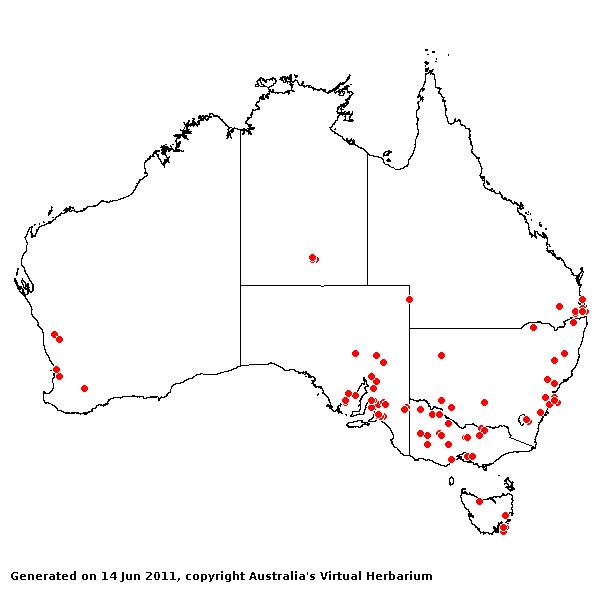Triticum aestivum* L. Sp. Pl. 1:
85 (1753).
Classification. (GPWG 2001) : Subfamily Pooideae.
Tribe Triticeae.
Type of Basionym or
Protologue Information: LT: "Triticum 3" Herb. Clifford no. 24,
(BM). LT designated by Bowden, Canad. J. Bot. 37: 674 (1959).
Key references
(books and floras): [1952] C.A.Gardner, Flora of Western Australia 1
Gramineae (59 as Trisetum pumilum), [1981] M.Lazarides in
J.Jessop (ed)., Flora of Central Australia, [2002] D.Sharp &
B.K.Simon, AusGrass, Grasses of Australia, [2006] J.Jessop,
G.R.M.Dashorst, F.M.James, Grasses of South Australia (279), [2008]
S.W.L.Jacobs, R.D.B.Walley & D.J.B.Wheeler, Grasses of New South Wales
(391), [2009] A.Wilson (ed.). Flora of Australia, Vol 44A. Poaceae 2
(107).
Illustrations:
[1952] C.A.Gardner, Flora of Western Australia 1 Gramineae (199,
Pl.59 as T.vulgare), [1984] N.T.Burbidge. rev. S.W.L.Jacobs, Australian
Grasses (269), [2006] J.Jessop,
G.R.M.Dashorst, F.M.James, Grasses of South Australia (280, fig. 217), [2008] S.W.L.Jacobs,
R.D.B.Whalley & D.J.B.Wheeler, Grasses of New South Wales, 4th edn
(391), [2009]. A.Wilson (ed.), Flora of Australia 44A: Poaceae 2
(106, Fig.15).
Habit. Annual.
Culms erect, 60–100 cm tall. Mid-culm internodes hollow, thin-walled.
Leaf-sheaths glabrous on surface or hairy. Leaf-sheath auricles present. Ligule
an eciliate membrane, 1–1.25 mm long, hyaline, truncate. Leaf-blades flat,
10–60 cm long, 7–15 mm wide. Leaf-blade surface scabrous, indumented.
Inflorescence.
Inflorescence solid, a raceme. Racemes 1, linear or oblong, 5–18 cm long,
bearing 16–20 fertile spikelets on each. Rhachis tough.
Spikelets.
Spikelets sessile. Fertile spikelets many flowered, with at least 2 fertile
florets (2–4), comprising 2–4 fertile floret(s), with diminished florets at the
apex, ovate, laterally compressed, 10–15 mm long.
Glumes.
Glumes similar. Lower glume elliptic or ovate, chartaceous or coriaceous,
keeled, 2-keeled, winged on keel, 5–9 -nerved. Lower glume surface glabrous or
indumented. Lower glume apex muticous or mucronate or awned. Upper glume ovate,
6–11 mm long, coriaceous, keeled, 2-keeled, 5–9 -nerved. Upper glume surface
glabrous or indumented. Upper glume apex with a unilateral tooth, muticous or
awned.
Florets.
Fertile lemma 10–15 mm long, keeled, 5–10 -nerved. Lemma apex muticous or
awned, 1 -awned. Median (principal) awn 0–150 mm long overall. Palea 2 -nerved.
Anthers 3. Grain 5–7 mm long.
Continental
Distribution: Europe, Africa, Temperate Asia, Tropical Asia, Australasia,
North America, and South America.
Australian
Distribution: Western Australia, South Australia, Queensland, New South
Wales, Victoria, Tasmania.
Western Australia:
Drummond. South Australia: Gairdner-Torrens Basin, Flinders Ranges, Eyre
Peninsula, Northern Lofty, Murray, Yorke Peninsula, Southern Lofty. Queensland:
Darling Downs, Moreton. New South Wales: Central Coast, Southern
Tablelands, Central-Western Slopes. Victoria: East Gippsland, Eastern
Highlands, Gippsland Plain, Grampians, Lowan Mallee, Midlands, Murray Mallee,
Otway Plain, Riverina, Volcanic Plain, Wannon, Wimmera. Tasmania: No
region given.
Notes.
Cultivated as a cereal.
In
all states except N.T. Perhaps not truly naturalized; usually appearing where
seed is dropped but rarely persisting.

